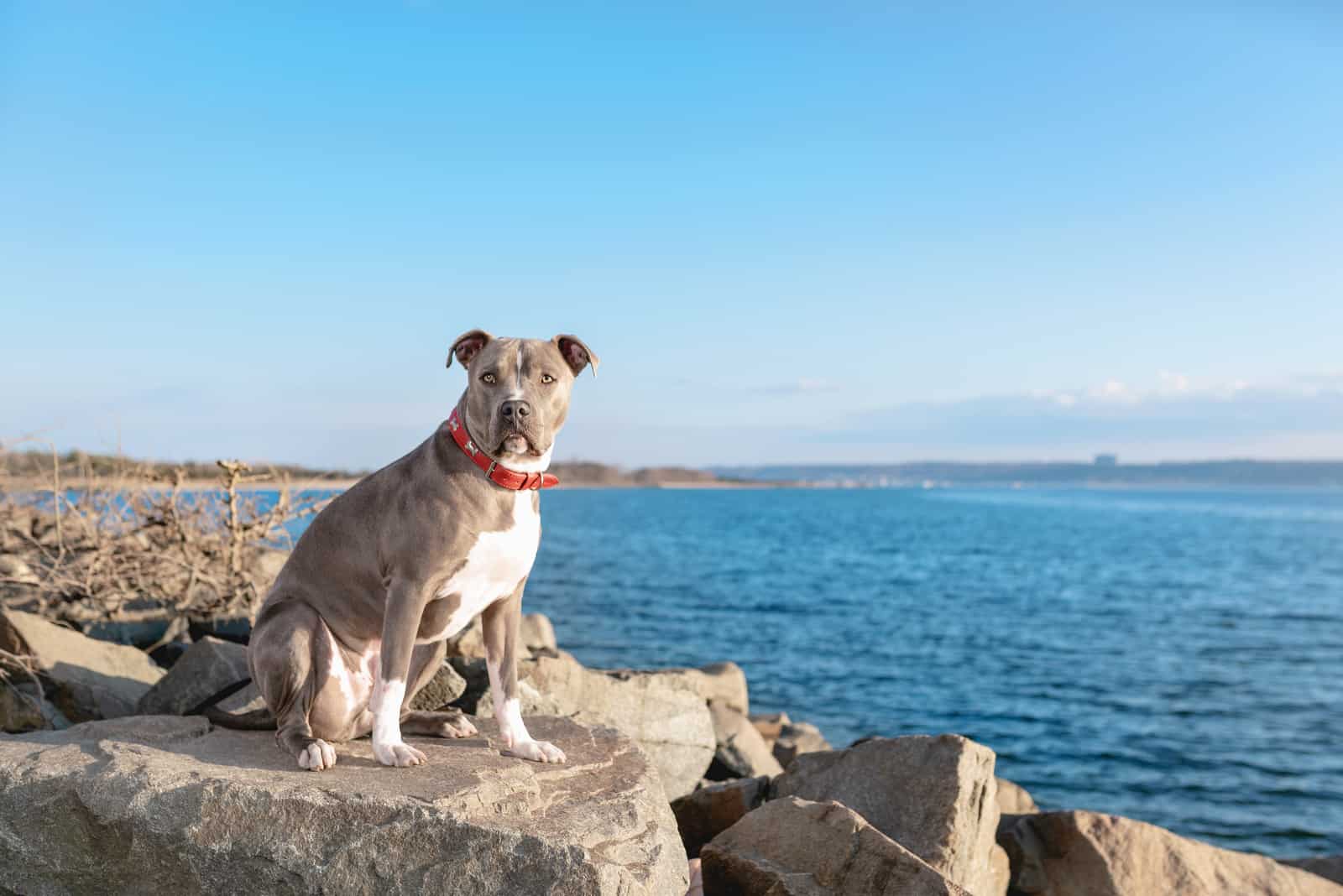While Pitbulls are dogs with a bad reputation, no one can deny that they are among the most gorgeous dogs out there – especially when they come in rare colors.
If you look at pictures of champagne Pitbulls, chances are you won’t be able to look away. These dogs will catch all the eyes, and be in the center of attention no matter where they go.
Champagne Pitbulls are considered very rare in the breed, which is why this Pitbull color is very sought after. In fact, champagne Pitbulls are among the most expensive purebred Pitbulls out there!
Why is this color so special, and why isn’t a champagne color more common in this dog breed?
Before we find out, it’s important to note that Pitbull is an umbrella term used for several breeds. All are descendants of Bulldogs and Terriers. Most commonly, Pitbull is a word used to name these breeds:
• American Pitbull Terrier; a dog we’ll focus on the most.
• American Staffordshire Terrier.
• Staffordshire Bull Terrier.
Now that we’ve cleared that up, let’s learn more about champagne Pitbulls and all the color combinations they come in:
Champagne Colored Pitbull
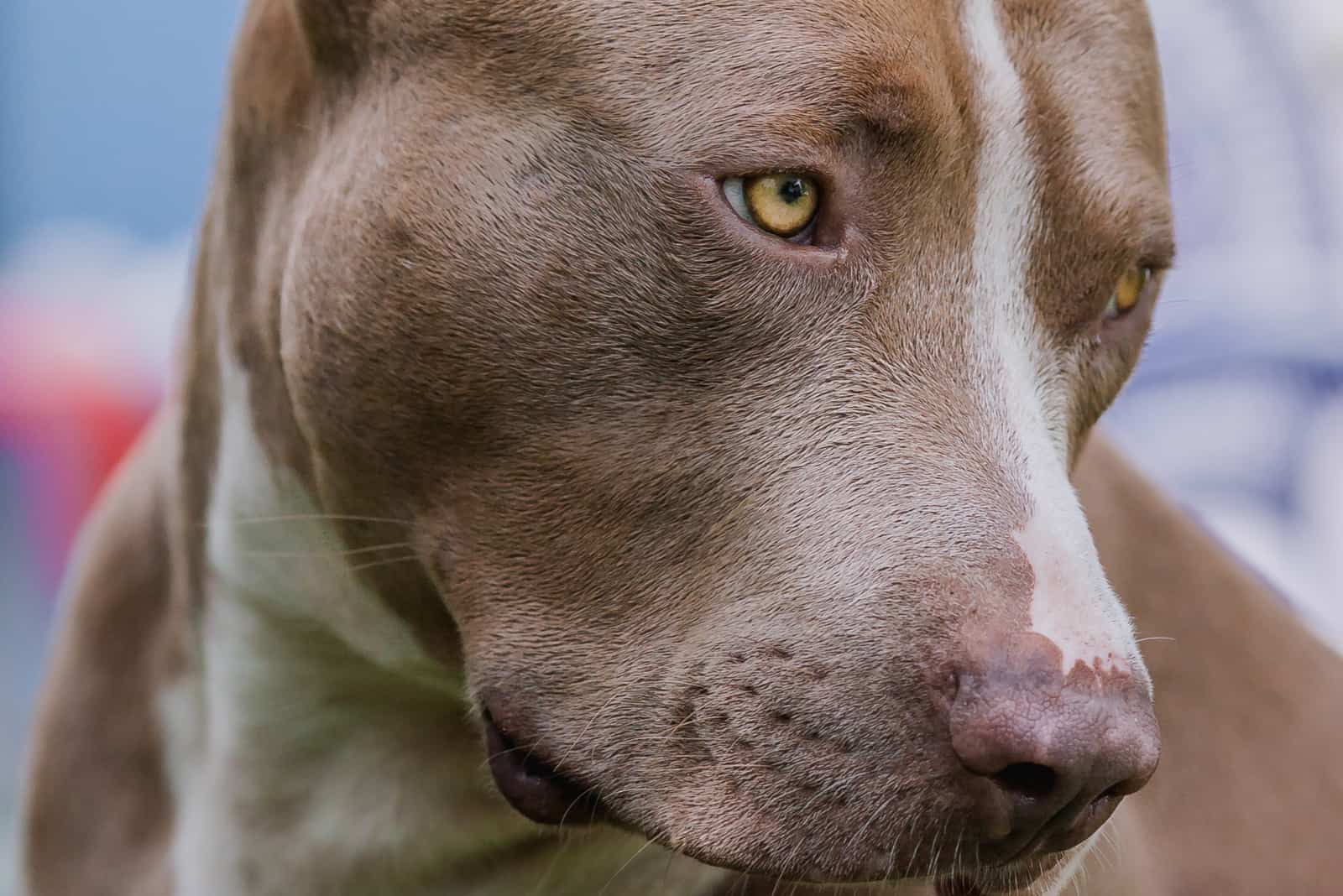
Champagne Pitbulls were bred specifically to have a pale shade of a yellow or cream coat that looks a lot like what we call a champagne color.
This coat color is present at the dog’s birth, but it’s extremely difficult to inherit. This is because it’s caused by a recessive dilution gene on the D-locus. This dilution gene doesn’t dilute black color as many other dilutes do. Instead, it deletes the red coat color.
As this specific gene is recessive, it needs to be inherited from both parents. Also, this is why this specific gene can oftentimes be passed for generations without expressing itself.
In fact, according to canine genetics, champagne Pitbulls are considered to be diluted red in color.
Champagne Pitbulls might look like they have a matte coat, especially at first glance. This is because their light color doesn’t have much shine to it, but this isn’t due to some illness or bad coat care. It’s simply how they are. Of course, this is assuming you’re getting them from reputable, ethical Pitbull breeders.
However, solid-colored champagne Pitbulls aren’t the only variation of these beautiful dogs. There are several more color combinations and color patterns that you can find.
We’ll go over some of the most popular ones, but first, we’ll look at the genetics behind this color.
Champagne Pitbull Genetics
The champagne Pitbull color is caused by a dilution gene called MLPH. MLPH’s primary role is to fix and transport cells containing melanin.
MLPH affects both pheomelanin and eumelanin pigments. These are two types of pigment that control what coat color a dog will have. Eumelanin causes black and brown color, while pheomelanin causes red and yellow tones.
As a result, MLPH will cause a diluted yellow coat color, which is the best way we can describe a champagne color. Pup’s genes have to be recessive (d) to get this precise shade.
As such, the only way a puppy will have a champagne coat color is if it inherits the recessive dilution gene from both of its parents. This is because a dominant allele, if present, will always override a recessive one, forbidding it from expressing itself.
While champagne Pitbulls are a result of mutations, they are not considered faults. This is because the champagne color doesn’t lead to any disability or defect. The MLPH gene affects only the dog’s skin and coat color, and nothing else. As such, the only thing that’s changed is the dog’s appeal.
Do Major Kennel Clubs Recognize Champagne Pitbulls?
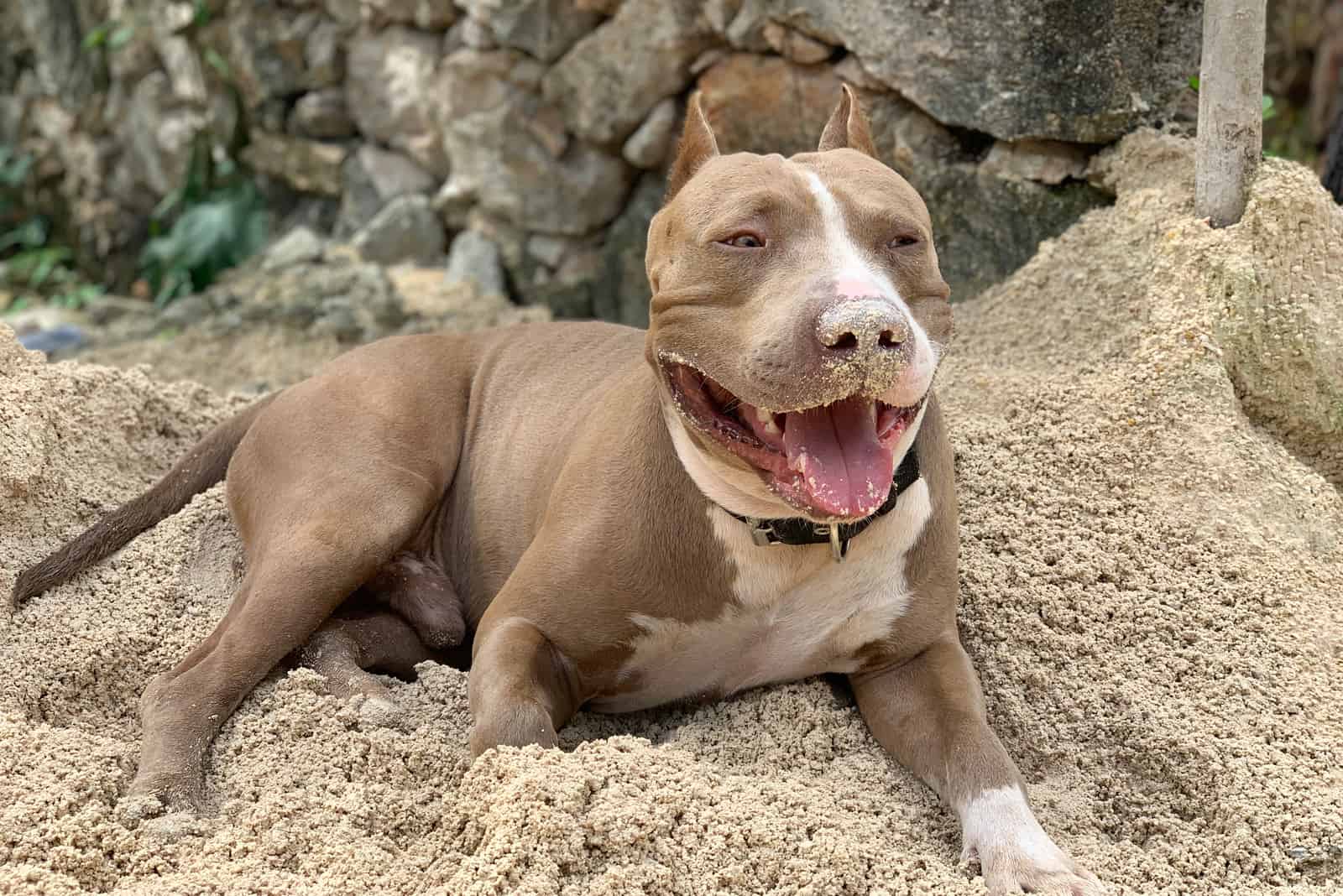
Major kennel clubs are organizations that stand behind a dog’s breed standard in a certain region. It is their goal to help improve all dog breeds and preserve bloodlines.
Two of the largest kennel clubs are the American Kennel Club (AKC), and the United Kennel Club (UKC). However, only the latter accepts champagne as a standard color of Pitbull dogs.
The UKC clearly states that Pitbulls of all colors are accepted within their organization, with the exception of merle, for the reasons we’ll talk about later on.
The UKC even recognizes all variations of the champagne color, such as lilac champagne or blue champagne coat colors.
Another large kennel club that recognizes champagne Pitbulls is the American Bully Kennel Club (ABKC). According to its breed standard, all colors and patterns are allowed in this breed – once again, with the exception of merle.
However, champagne Pitbulls are not recognized within the AKC, but this is due to one catch.
The AKC doesn’t recognize American Pit Bull Terriers, which are Pitbulls that usually come in champagne color. Instead of them, they recognize American Staffordshire Terriers, and they allow this dog breed to come in any color – except patched Pitbulls with more than 80% of a solid white coat.
As such, if you own an American Staffordshire Terrier with a champagne coat color, you can stay calm knowing that the AKC would recognize it.
Champagne Pitbull Variations
Champagne Pitbulls don’t just come in one solid color, or in one shade. There are several different color variations they can come in, which just makes everything much more interesting and unique.
Here are some of the most popular ones you can find:
Blue Champagne Pitbull
Blue Pitbulls are a result of another diluted gene. This one, however, affects black color, turning it into a specific bluish shade of gray. Hence, the name blue Pitbulls.
Blue Pitbulls are commonly known as blue nose Pitbulls, and you might know them under this name. However, why focus on the nose if the dilution gene affects coat color?
This is because the dilution gene that causes blue coat color doesn’t necessarily affect the dog’s fur, but it always affects the dog’s skin. A Pitbull’s base coat color doesn’t have to be black, but certain parts of his skin always are. This includes the dog’s nose, eye rims, lips, and paw pads.
As the blue dilution gene will affect any black pigment, this means that it’ll always affect these skin parts. Out of all of them, the nose is the one we can see the easiest, which is why these dogs are known as blue nose Pitbulls.
Blue nose Pitbulls can come in any color other than black, and this includes blue fawn, blue brindle, and even blue champagne Pitbulls. As the MLPH gene doesn’t affect the black color, these two genes can exist in correlation.
Breeding blue nose champagne Pitbulls requires breeding experience that not many kennels have. This is why they are some of the most challenging dogs to breed and find.
Champagne Lilac Pitbull
Lilac and champagne are two colors that are often misused. Both shades are pretty similar, and they can look the same to someone who doesn’t know what to search for. However, they are caused by entirely different genetics.
Unlike champagne, lilac is a double dilution. It is caused by a dilution of a chocolate/liver color, which is the dilution of a black gene.
A champagne lilac Pitbull doesn’t exist as a shade on its own, as the two dilution genes cannot express themselves at the same time. Instead, these two colors are usually used at the same time to describe the same dog – although determining the right color might be a challenge.
Champagne Fawn Pitbull
Similar to lilac champagne Pitbulls, fawn is another color that many people use to describe champagne color in dogs. In fact, if we look at champagne Pitbulls, their coat is almost the same shade as fawn Pitbulls.
However, as many breeders state on their FAQ pages, there is a huge difference in their genetics, as fawn is a ‘true’ color. It doesn’t come from a dilution gene.
From the viewer’s standpoint, the biggest difference is in the dog’s nose and eye color. Fawn Pitbulls have a black nose and dark, brown eyes. No dilution gene is messing with the pigment of their skin and eyes, and this difference is highly visible.
Champagne Brindle Pitbull
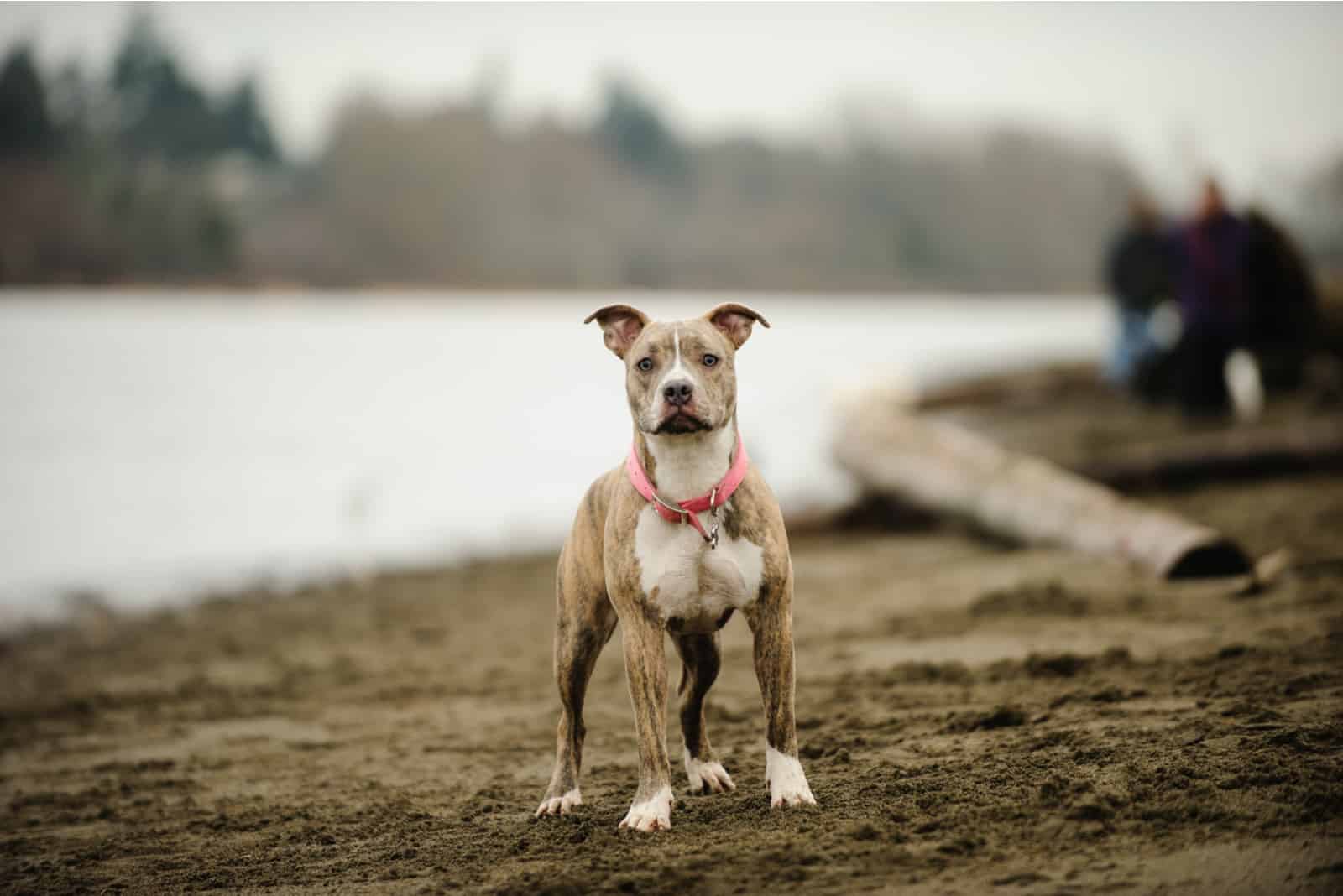
Brindle isn’t a coat color, but rather a pattern. If you’ve seen dogs with tiger-like stripes – that is what a brindle dog is.
Brindle is caused by a dominant gene – the most dominant of all, as a matter of fact. However, this gene affects the pattern and not the base coat color of the dog.
While many brindle dogs have black stripes, this isn’t a necessary color. Instead, these stripes can come in any color as long as they are darker than the base.
As such, it’s possible to have a champagne brindle Pitbull. However, due to challenging breeding practices that are necessary to implement, these dogs are almost impossible to find.
A champagne brindle Pitbull won’t have dark stripes like many other brindle colors. Instead, it will have barely noticeable stripes of a darker champagne shade.
Champagne And White Pitbull
Champagne Pitbulls with white markings are the most common champagne Pitbull color. These dogs will usually have white spots on their chest, tummy, and feet, but the markings can cover any part of their body.
The only time when white spots are an issue is if they are covering more than 80% of the dog’s body. These dogs are not recognized by kennel clubs, and they might be connected to certain health problems.
As such, dogs with a predominantly white coat and champagne markings are not considered desirable.
Champagne Tri Color Pitbull
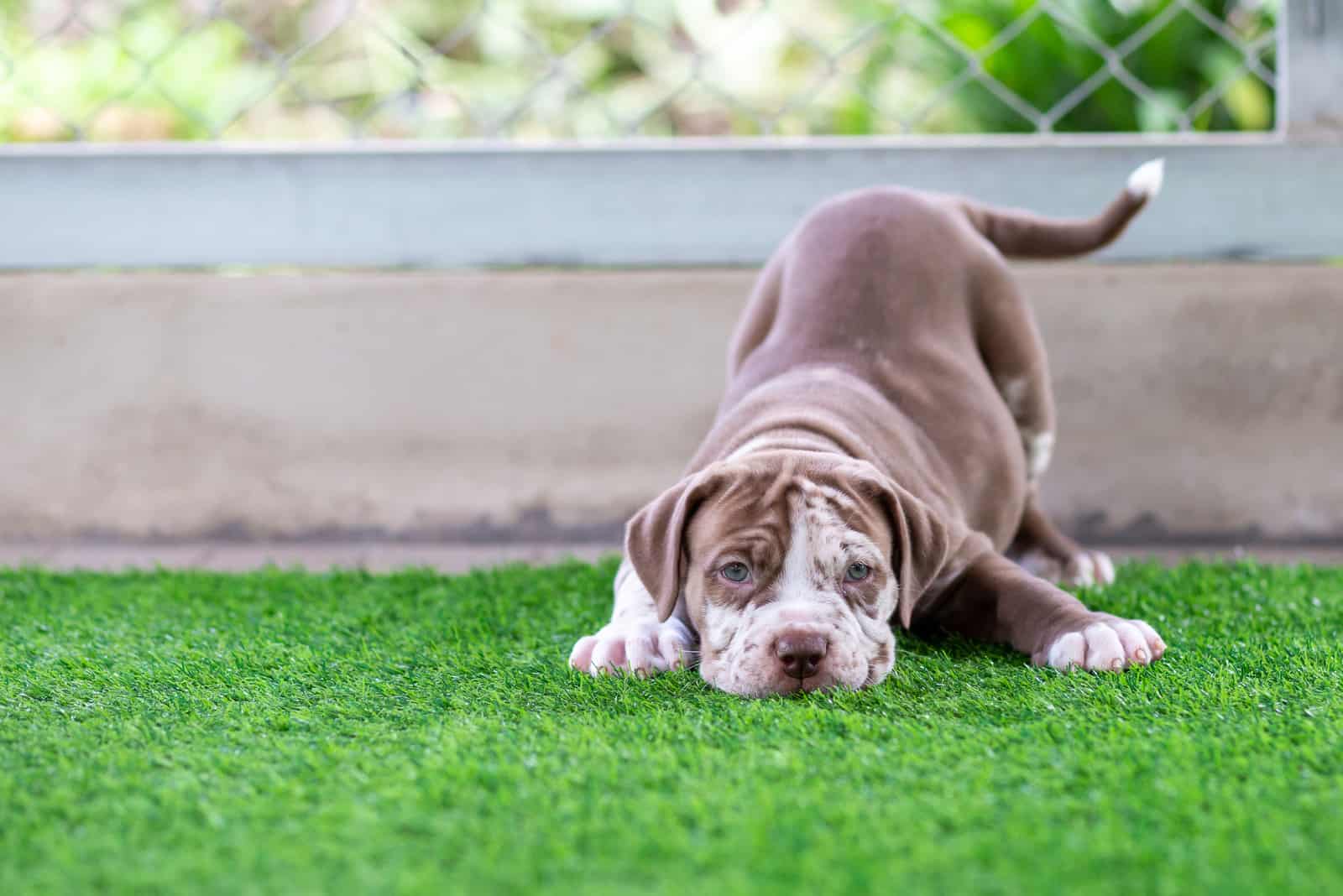
While many dog lovers would love to get a champagne tri-color Pitbull, this isn’t really possible.
We’ve already mentioned that the champagne color is the result of a specific dilution gene on the D-Locus that produces coats that can be anywhere between pale yellow, cream, or pearl shades.
The genes behind this recessive red color hide any pattern that can be expressed from the A-Locus. As such, any tan marking is impossible, and they are necessary for a Pitbull to be considered tri-colored.
Despite this, there are many breeders out there who claim to breed champagne tri-colored Pitbulls in their kennels. However, they are most likely mistaking a lilac tri-color Pitbull with a champagne tri-color.
Unlike champagne Pitbulls, lilac Pitbulls can be tri-colored. This is because the genes that cause the lilac color don’t hide tan points, which is why such markings are possible on lilac Pitbulls.
We’ve stated that lilac is the result of a dilution gene that messes with the chocolate color. However, chocolate and red don’t belong to the same allele, so this dilution gene won’t affect the tan markings.
Champagne Merle Pitbull
Merle is the most controversial pattern of them all. It is caused by a specific merle dilution gene that is found on the M-locus.
Unlike most other dilution genes, merle doesn’t simply dilute the pigment. Instead, it will create a spotted pattern that will usually consist of white markings and irregular spots of two shades of the same color.
The same gene causes a dog’s eyes to turn blue, although heterochromia is the most common outcome.
The problem arises when a dog inherits a merle gene from both of its parents. These so-called double merles have an entirely white coat and blue eyes, which can make them a gorgeous sight.
However, in double merles, the dilution gene has affected not just their skin and fur, but also their ears, bones, and heart. As such, these pups are prone to many health problems, and are almost always deaf.
While this issue sounds like it can be easily avoided by not breeding two dogs with a merle pattern, there are cryptic merles. These dogs are carriers of the merle gene, but this gene is hidden. Unless extensive DNA testing has been conducted, it is challenging to even get an idea of which dog might be the carrier of the merle gene.
Because of this, the intentional breeding of merle dogs is considered unethical, and it’s frowned upon by most responsible breeders.
When it comes to merle champagne Pitbulls, these are usually lilac dogs confused with champagne ones. Getting a champagne merle is possible, and these dogs will simply have two very similar colors on their coats, along with white markings.
Champagne Red Nose Pitbull
Plainly speaking, champagne red nose Pitbulls are all champagne Pitbulls that are not blue.
Red nose Pitbulls are, in fact, liver or chocolate Pitbulls. They are the result of a specific gene that dilutes the color black. This is similar to the blue dilution gene. However, this specific gene turns black into reddish shades, such as chocolate.
As champagne Pitbulls are caused by a red dilution gene, they will always be considered red nose Pitbulls since their noses will always be light brown or pink.
Champagne XL Pitbull
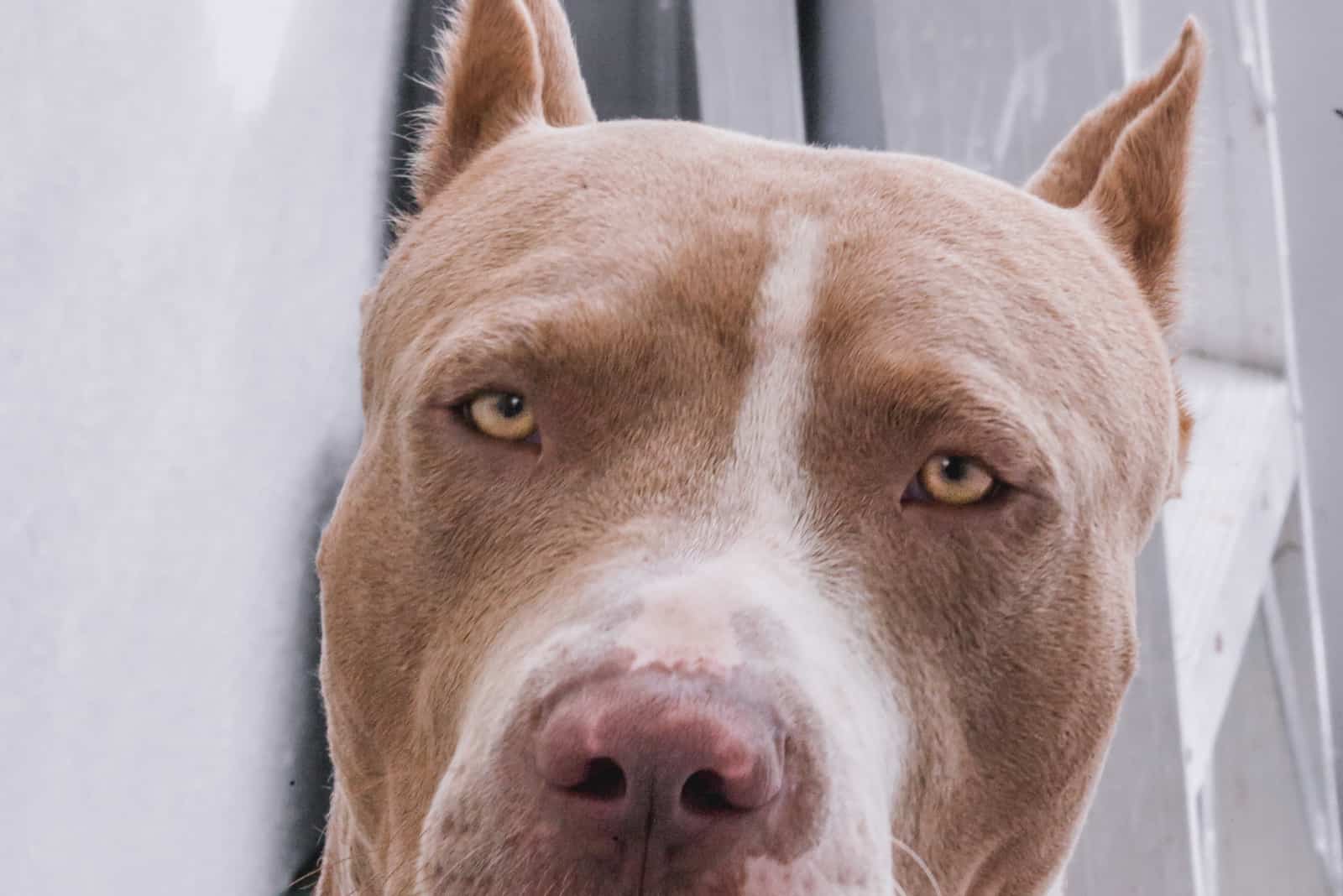
A champagne XL Pitbull is a dog of an American Bully breed that comes in champagne color.
American Bullies are a breed of large Pitbulls. Some of them are even known as XXL Pitbulls! There are several famous bloodlines of Bully Pitbulls – the most notable ones are sold at ManMade Kennels or belong to the Gotti Pitbull bloodline.
American Bullies can come in any color that regular Pitbulls come in. As such, you can find champagne Bullies of most bloodlines.
Champagne Pitbull Puppy
Breeding champagne Pitbull puppies can be a challenge. Finding one can be an even bigger challenge, as most of these dogs get sold out rather quickly.
To get a champagne Pitbull puppy, you’d have to breed two champagne Pitbulls. While theoretically, you can get a champagne Pitbull from breeding two dogs with an MLPH gene, it is extremely hard to predict what the litter would look like. Many times, only a quarter of the litter will come in champagne color.
Once the genes are right and the champagne Pitbull puppy is born, raising it is the same as raising any Pitbull puppy.
These dogs require lots of playtime because of their high energy levels. Early socialization is essential, especially since Pitbulls are considered a dangerous breed.
If you’re planning on buying a champagne Pitbull puppy, be prepared to supply him with everything he needs for proper development beforehand – such as harnesses, food bowls, toys, and brushes. This is the only way to ensure you’re getting the best dog possible.
Are Champagne Pitbulls Rare?
https://www.youtube.com/watch?v=_aqu06kuSWw
Because they are a unique breed variety, champagne Pitbulls are rather rare, but they aren’t the hardest Pitbull color to find. They are not as common as some standard colors, such as fawn or black coats.
The main cause of this is the challenging breeding practices required to get a champagne Pitbull puppy. Producing these dogs will cost a Pitbull breeder a lot of money, which is why these pups can be quite expensive.
Champagne Pitbull Puppies For Sale – Champagne Pitbull Price
If you’re looking to buy champagne Pitbulls, you need to be prepared to spend a bit more money than you would for a Pitbull of some other, standard coat color – especially if you’re buying from a reputable breeder, which is something we’d always recommend.
Most champagne Pitbulls will cost between $2,000 and $2,500. Compared to Pitbulls in some more standard colors, which cost between $650 and $1,000, this is a big difference.
The biggest reason behind such a high price of a champagne Pitbull pup is that they are challenging to breed. A good breeder has to find two perfectly healthy champagne Pitbulls and have them mate, and this isn’t always an easy task.
Of course, the color’s popularity and demand will always impact the price. This is why sometimes, the price of a dog today can be much higher than its price even just a year ago.
The expenses don’t end just because you’ve purchased a champagne dog. Quite the opposite – if you’re not careful, they can skyrocket.
Puppies can be expensive to maintain. Not only do they require at least three vet visits in their first year (this includes all the necessary vaccinations, deworming, and spaying and neutering), but you’ll likely have to purchase many dog items for the first time.
In fact, you can expect to spend anywhere between $1,000 and $4,000 in your dog’s first year of life!
Fortunately, as they turn into adults, these expenses get lower. You’ll mostly pay for dog food, a new item here and there, and only one vet visit per year.
When your Pitbull grows old, though, expect to have a bit more expenses, especially in medical bills.
Champagne Pitbull Lifespan
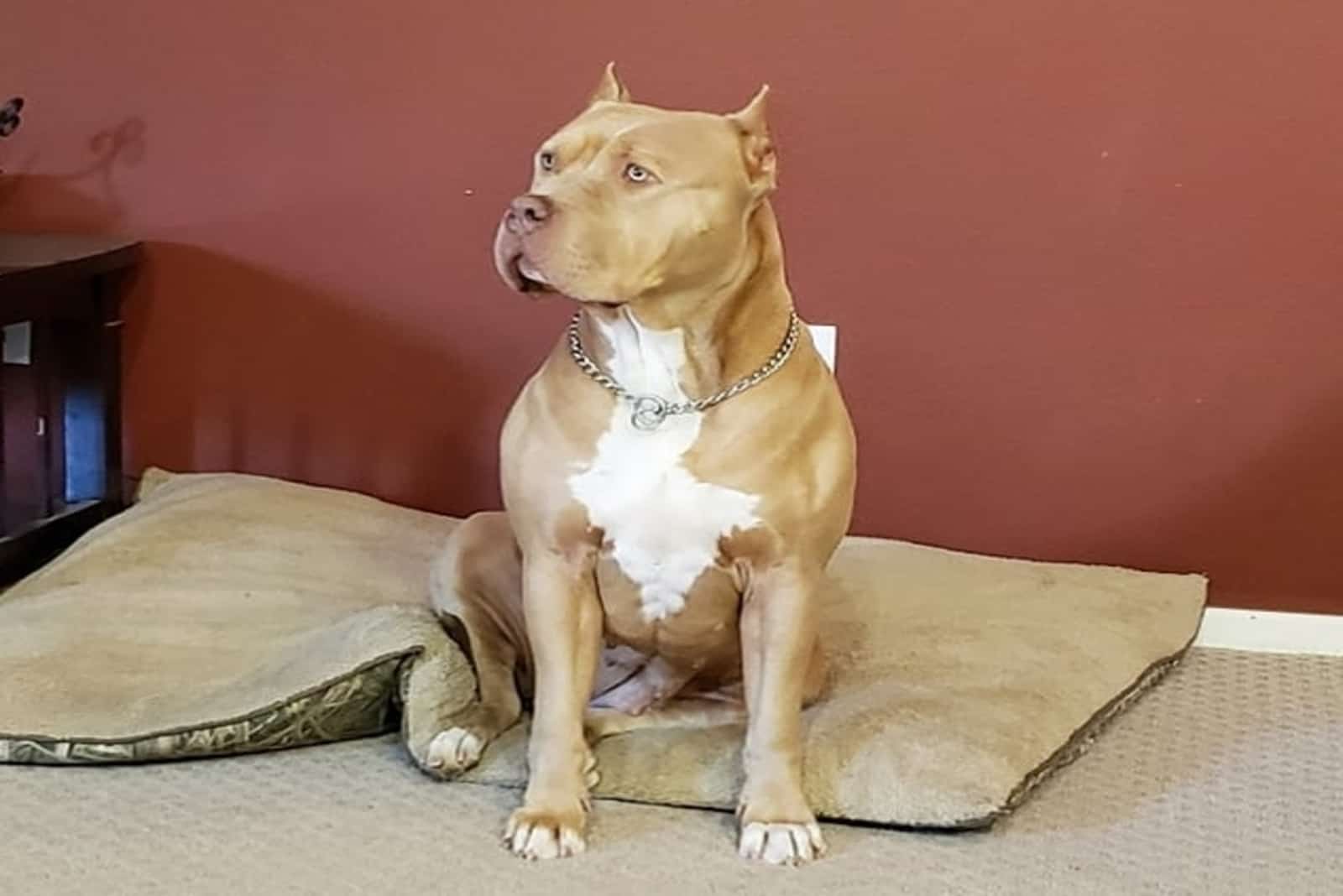
Photo from:@patriotbullyhouse.llc
The MLPH gene doesn’t affect anything but the Pitbull’s coat color, changing it to the diluted pale yellow shade you see on them. As such, they have a lifespan of 12 to 14 years, just like Pitbulls of all other colors. Of course, this is presuming you take them for regular vet check-ups and feed them the best possible food.
However, all Pitbulls are prone to some health problems. Three of the most common ones include:
• Hip dysplasia – This condition is caused by an abnormally formed hip socket. It can lead to more severe health conditions, such as arthritis. While this is a genetic condition, the best way to keep your dog from getting hip dysplasia is to make sure your Pitbull is not obese.
• Color dilution alopecia – Also known as canine color dilution alopecia, this is a hereditary skin disease that is very common not just in champagne Pitbulls, but in blue Pitbulls, lilac Pitbulls, and other dogs with a dilution gene. The first sign of color dilution alopecia is the onset of a dull and dry coat, followed by partial hair loss.
• Cerebellar ataxia – This health condition causes poor coordination of the muscles. Dogs with cerebellar ataxia will be more prone to uncoordinated movements, tremors, and sometimes even paralysis.
XL Pitbulls, including champagne ones, are also more prone to some more severe orthopedic health conditions, which are usually caused by obesity. As such, it’s important to make sure you are giving them the best dog food possible, and to be careful not to overfeed them.
Are Champagne Pitbulls Dangerous?
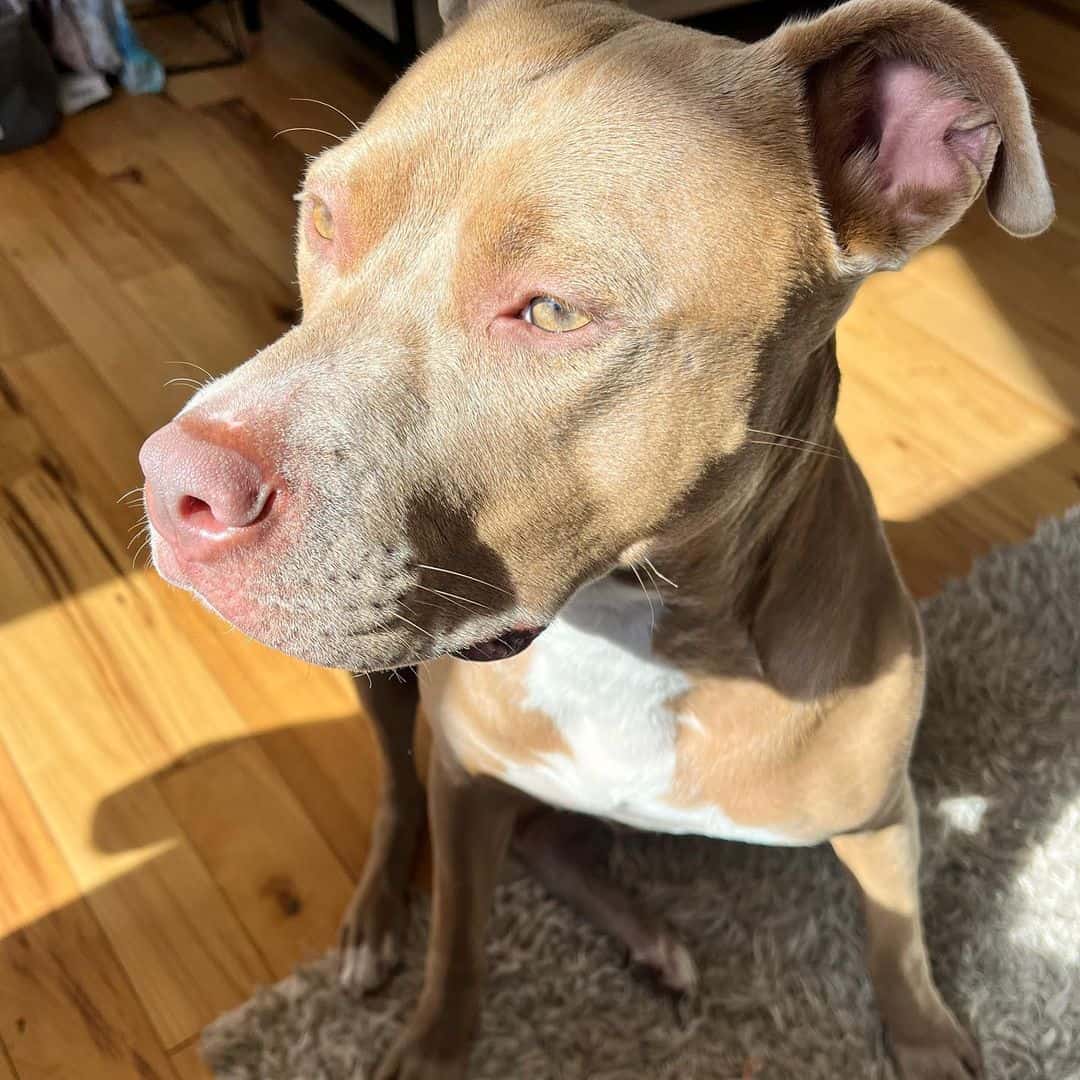
Photo from: @eqoa.odie.lennox
Unfortunately, Pitbull dogs have a very bad reputation, and many people claim that they are an aggressive breed. However, this isn’t exactly the case.
Pitbulls are known as very friendly, sociable dogs. While they are very protective and have a bad history due to being used in fighting pits for decades, they are very affectionate toward humans.
Other than their unique coat color, champagne Pitbulls are in no way different from the rest of the breed. Their color doesn’t affect their behavior in any way.
A champagne Pitbull will be very patient with toddlers and even young kids. They are among the most well-known nanny dogs and therapy dogs, and they’ll make amazing protectors for your little ones. They love to play and cuddle, making them the perfect combination with children.
As long as you’ve given them proper socialization from a young age, champagne Pitbulls will be very friendly with strangers. They have a strong intuition, and they might not love people they consider a threat.
However, if a human provokes them, they can be very aggressive and vicious because they are extremely brave. This type of temperament is what makes them some of the best watchdogs in the canine world.
Unfortunately, this bravery is what made people use them as fighting dogs for many years. Because of such history, champagne Pitbulls might be a bit wary when they meet new pets and dogs, especially during the first meeting.
Still, just like with strangers, if you’ve socialized them on time and taught them how to behave in new environments and situations, they can live in harmony with not just other dogs, but smaller animals, such as cats, as well.
Before you get yourself a champagne Pitbull pup, make sure you’ve done your research, so you can know what to provide your new dog with.
Not all dogs are for everyone, and it’s important to see whether a champagne Pitbull will be a good fit for your lifestyle.
Read Next: Top 7 Pitbull Breeders In Ohio: Get Your Nanny Dog From ‘Em
